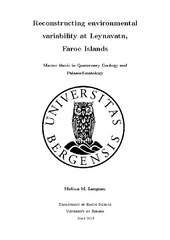Reconstructing environmental variability at Leynavatn, Faroe Islands
Master thesis
Permanent lenke
https://hdl.handle.net/1956/20438Utgivelsesdato
2019-06-26Metadata
Vis full innførselSamlinger
- Master theses [106]
Sammendrag
A new continuous environmental reconstruction has been established based on a 390 cm long lake core from Leynavatn Streymoy (southeast Faroes Islands), containing sediments spanning from the last 550 CE (Common Era). To acquire further understanding, the lake core is compared to other proxy records from the North Atlantic region to examine the amplitude and timing of regional climate variability. A firm chronology is generated by radiocarbon dating from the sediments. In addition, magnetic susceptibility, loss-on-ignition, XRF-core scanning and X-ray CT-scanning were used to unravel different catchment activities. A simplified Quaternary geological map is proposed to explore the present activity and define different catchment processes. Leynavatn sediment record suggest that the concentration of geochemical elements Ti, Ca and K, together with dry bulk density and magnetic susceptibility reflect changes in amount of inorganic delivery to the lake. In contrary, the geochemical ratio Incoh/Coh scattering and loss-on-ignition reflect variations in the organic input. These proxies are associated to landscape changes, which are sensitive to late Holocene climate variability and the human expansion at the Faroes. The results from Leynavatn sediments indicate that all climatic induced phenomena including precipitation, atmosphere and sea surface temperatures, underwent an evident change at the transition from Medieval Warm Period to the Little Ice Age. The geochemical and geophysical changes in the lake sediments are associated with enhanced weathering and increased erosion around 1200-1400 CE, referring to the Medieval Warm Period. After 1400 CE a prolonged decrease in inorganic delivery propose a climatic cooling, where increasing frequency of cold summers and cold winters reflect the onset of the Little Ice Age.
